Rhapis palm aren’t the most popular palm for Australian gardens but they have a unique history and botanical significance which is often overlooked. What’s more, their soft bristled foliage makes them one of the most beautiful plants for your garden, thanks to the gently filtered light, and the calm rustle of papery leaves in the wind.
We’ve put together a full guide on how to grow, propagate and care for Rhapis palm, whether you’re growing it indoors or outdoors, as well as some handy tips for getting the most out of these slow-growing palms.
More...
Family: | Arecaceae |
|---|---|
Genus: | Rhapis |
Species: | R. excelsa |
Common Names: | Rhapis palm, Lady palm, Broadleaf lady palm, Bamboo palm, Fern rhapis |
Location: | Indoor or outdoor |
Type: | tree, shrub, plant, ground cover, hedge |
Growth: | H 4m x W 4m (slow growing) |
Sun requirements: | Full sun to shade |
Foliage Colour: | Green |
Flower Colour: | Yellow |
Flowering: | Summer |
Fruit: | Small white fruits containing individual seeds, late summer |
Maintenance level: | Low |
Poisonous for pets: | Non-toxic to cats and dogs |
What is Rhapis Palm?
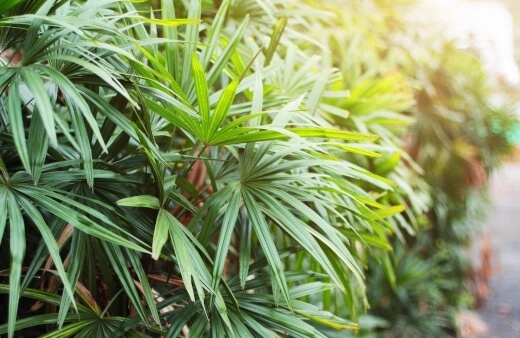
Rhapis palm is a popular house plant but grows best outdoors in Australia where they benefit from better airflow, and seasonal changes. This helps them to regulate flowering and fruiting times.
While they are easy to keep, they are slow growing and will eventually reach a height of 4m after 20+ years. Rhapis excelsa, to give it its proper name, is a clump-forming evergreen shrub, rather than a tall common palm.
This makes them ideal for gardens with loam soil, where they will colonise slowly, and are far easier to control than other plants used for the same purpose, like bamboo.
Natural Habitat of Rhapis excelsa

Rhapis palm are native to mountainous woodlands in Southeast China, Vietnam and Hainan, but have been naturalised through introduction into Japan, Southern China and Thailand.
What’s truly fascinating about these plants is that through historical botanical collections, they are now safer in cultivation than in the wild.
As frost-hardy, evergreen perennials, with high disease tolerance, their main enemy is deforestation. In their native Southeast China, they are rarely found in the wild today and are much more common in our homes and gardens.
While they are not endangered in the wild, thanks to naturalisation throughout Southeast Asia, it is horticultural collectors who are ensuring the continued survival of this tough garden plant.
How to Grow Rhapis Palm
Rhapis excelsa can be grown indoors or outdoors but is much happier in the garden, than in the conservatory. Like all palms, airflow and seasonal change help these evergreen plants to regulate their flowering and fruiting times, and trigger flushes of growth in spring, rather than consistent slow growth throughout the year.
Below, we’ve got guides on how to prepare your space for growing Rhapis palm, both indoors and out, to make sure you can keep your plants happy and healthy.
Growing Broadleaf Lady Palm Indoors
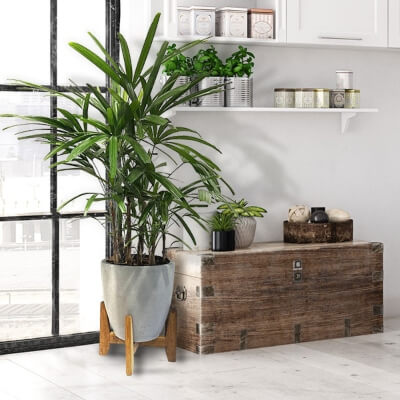
Source: gardenexpress.com.au
Broadleaf lady palm prefers to be grown outdoors in Australia but can often continue to thrive in containers indoors, even placed on a plant stand, provided they have good ventilation and are allowed to experience changing temperatures throughout the year.
Growing Lady palm in a standardly air-conditioned building will eventually limit the plant’s growth and annual habits – essentially it won’t know when summer is.
Below, we’ll look at the best conditions for Lady palm indoors:
Soil / Drainage
Rhapis palm likes loamy soil, providing a good balance of clay, sand and silt so it has equal measures of water retention and drainage. The easiest way to archive this is to mix compost, grit, and garden soil together in a pot.
Weeds are likely to pop up from the garden soil but will be easy to manage in indoor containers, and Rhapis palm does not mind competition.
Light
Rhapis palms are probably the least fussy houseplant you can buy. They will grow happily in full sun or shade but are happiest in low, dappled light without direct afternoon sun.
The only light conditions that Rhapis palm won’t tolerate are midday sun or complete darkness.
Temperature
Rhapis excelsa don’t like extreme high temperatures. Anything over 37°C is likely to burn their thin papery leaves, so provide them with plenty of shade, particularly in WA, whether they’re indoors or out.
Watering Indoors
Rhapis palm likes loamy soil because it doesn’t encourage standing water. They like to dry out between watering but can cope with lightly overwatering occasionally.
For example, if you’re going on holiday for over a week, you can drench the plant until water runs out of the bottom of the pot. However, in normal times, give 1-2L of water per week, only if the soil has dried over the surface.
Ventilation / Humidity
Lady palm grows in mountainous woodland, and alongside river valleys in Southeast China and Vietnam. Those humid conditions can be hard to replicate in Australia, but misting a few times per week, or keeping a humidifier nearby can prevent the leaves from browning excessively in mid-summer.
Growing Rhapis Palm Outdoors
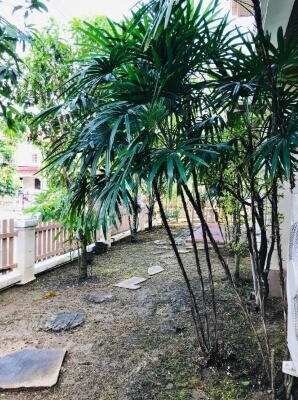
Rhapis palm are happiest outdoors in Australia, where they benefit from changing seasons. The only hard part is finding the right location. The basic rule is to find somewhere shaded, with reasonable drainage, and light wind. In those conditions, Rhapis palm will thrive outdoors in Australia.
Soil / Drainage
Rhapis excelsa likes reasonable drainage rather than ‘good drainage’, so for the average Australian garden (sandy), mix a bucket of compost through the planting hole to improve water retention.
The nutrients won’t do much, but the organic matter will help to retain rainwater, without completely waterlogging the plant.
Light
Avoid full sun, and take particular care to plant Rhapis palm away from the afternoon sun in the summer. The summer sun in Australia is enough to frazzle every leaf, so any protection you can provide is a bonus. Shaded positions are preferred.
Temperature
Rhapis palm can cope at any temperature from -6°C to 37°C so is pretty hard to kill outdoors, provided it’s planted in a cool position, away from the direct afternoon sun.
If there is a risk of frost near you over winter, simply wrap the plant in fleece for a few weeks to protect it. It’s unlikely the soil temperature will drop below -6°C so the roots will survive.
Fertiliser
For both indoor and outdoor Rhapis palm, any balanced liquid fertiliser is fine. There is no need to splash out on expensive foliage feeds, or specific NPK ratios.
Aim for a balanced organic plant food like liquid seaweed, or a standard tomato food and feed once a month with water throughout summer.
Lady Palm Propagation
There are three ways to propagate Rhapis palm, but one stands out as significantly more reliable. In all cases, you need access to your own Lady palm to begin with.
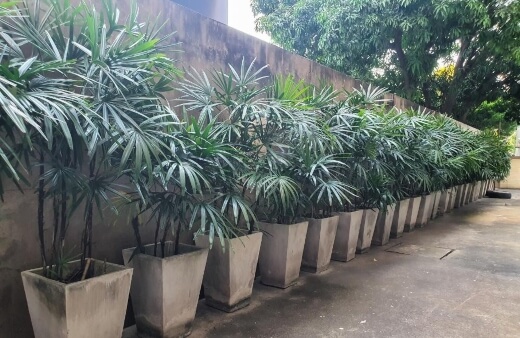
Propagating Rhapis Palm from Seed
Rhapis palm seeds are hard to come by, so it’s best to harvest your own where possible, though there are independent sellers with good reputations that offer fresh seeds if you prefer to grow from seed to begin with.
Once you’ve got your Rhapis seeds, propagation requires reasonably high temperatures (25°C or above) and high humidity. Scatter seeds loosely across seed compost, and water them really well.
Do not cover, as they need light to germinate. Place a plastic bag over the tray to increase humidity, and place them somewhere warm and bright for 3-6 months.
Rhapis palms are slow to germinate so be patient, and keep the soil moist. Because of the long germination time, there is no need to soak seeds first.
How to Propagate Rhapis Palm from Division
The best way to propagate lady palm is through division. Rhapis excelsa is a clump-forming palm so has clusters of short fleshy roots underground. Whether it’s planted in the garden, or in a container, the division is simple:
For Rhapis excelsa in the ground, use a strong garden fork to dig and loosen the soil around a clump of roots. Then, push the fork through between the stems, and attempt to dig out a 1ft square clump.
It should come away easily, but if not, you can use a hand saw to cut through any particularly tough roots. Replant the clump elsewhere with fresh compost added to the planting hole.
For lady palm in pots, simply tip the plant out of the pot, and pull sections off by hand. Try to keep 2-3 stems on each clump.
If the roots have become pot-bound, and are difficult to separate, push two garden forks into the container and pull them apart. This should tear the roots and help to encourage more fibrous roots in their new pot.
Rhapis Palm Propagation from Basal Cuttings
While it is possible to propagate from basal cuttings, it is much more reliable to separate small clumps from the parent with roots intact.
If, for whatever reason, you don’t wish to disturb the main root ball, you can use a sharp knife to slice the base of a fresh stalk from the fleshy root at its base – aim to keep a small piece of root attached to the stalk as this is packed with growth hormones and will quickly try to grow new roots.
Place the cut root in water for 4-12 days until you see small white roots starting to appear (change the water daily). When roots appear, place the cutting in a small pot filled with a mix of compost and grit (or sand). Keep moist until leaves appear.
Possible Rhapis Palm Pests and Diseases
Mealybug and Scale on Rhapis palm are the only truly common pests that affect these resilient palms in Australia. There will always be occasional aphid infestations on new growth, and leafcutter bees, caterpillars and leafhoppers will make a meal of their leaves, but it is rare that they will cause any significant damage to outdoor plants.
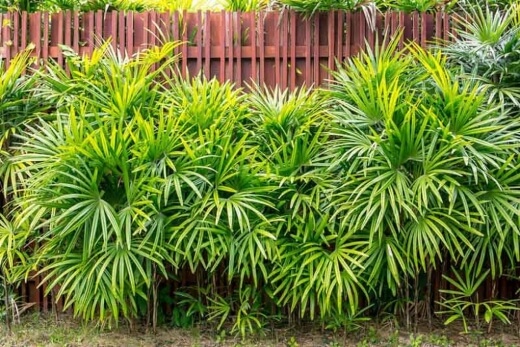
Source: gardenia.net
Indoor Rhapis palm can be severely affected by mealybug and scale though. Both are small insects which cover themselves in distasteful mucus, though mealybugs are more common, and easier to spot with bright white coatings.
To get rid of these frustrating pests, treat the entire plant with an organic insecticide like neem oil. Rhapis palm do not suffer from many diseases, and when they do it is usually caused by poor drainage or fungal infections which enter through damaged leaves.
Rhapis Palm Root Rot
Root rot in broadleaf lady palm is a sign of overwatering. The first symptoms are yellow, wilting leaves and browning stems. Remove the affected areas, and try to treat the root cause.
Overwatered, or waterlogged Rhapis palm is usually caused by boggy, or badly draining soil. It can be hard to improve soil once plants have become established, but if possible, remove the plant, and dig out a good amount of soil from the hole.
Add grit or sand to the base to create run-off, then shake off the wet soil from the roots. Replant with a good mix of compost and loamy garden soil.
Rhapis Palm Leaf Spot
Fungal leaf spots can occur for a number of reasons but are exacerbated by poor ventilation. Black spots on the leaves of palm trees are caused by fungal pathogens which enter the leaf through damage caused by insects or sunburn.
High humidity or standing water on leaves provided good conditions for funguses to multiply. If you notice black spots on the leaves of broadleaf lady palm, remove the affected leaves and burn them. Follow that with a treatment of an organic fungicide.
Rhapis Palm Frequently Asked Questions
Is Rhapis palm air purifying?
Rhapis palm is exceptionally effective at removing ammonia from the atmosphere and is recommended by NASA for that reason as an air purifier for your home or office.
They are not particularly strong oxygenators, but they are great at taking toxins out of the atmosphere.
Can you cut back Rhapis palms?
Rhapis palms do not need regular pruning, and cutting them back to the ground can allow moisture into cut stems that then affect the roots.
The best way to prune Rhapis excelsa is to selectively remove any brown or yellowing stems, to make way for fresh green shoots. This helps to aerate the plant too, which reduces the chances of disease.
Is Rhapis palm invasive?
Rhapis palm is not invasive and makes an excellent alternative to bamboo. While its roots can be destructive, they are incredibly slow growing, easy to remove, and only need management once every 5-10 years once they have been established in a bed or border. Simply pull the shallow roots from the ground.
How tall does Rhapis palm get?
Broadleaf lady palm can grow to well over 4m but takes around 20 years to reach its ultimate height. For indoor Rhapis palm to reach that height they would need incredibly large pots, and regularly dividing to reduce competition.
If you are looking to grow other palms in your home then be sure to check our growing guides below:
Wrapping Up Our Rhapis Palm Guide
Rhapis palms aren’t nearly as popular as they should be. While they are fairly humble and don’t give much drama to a garden, they are a gorgeous delicate foil for planting against fences or creating structure in borders.
They are easy to plant around, and simple to manage, so if you’re looking for a plant to change things up this year, Rhapis palm is well worth considering.
Published on July 31, 2022 by Maisie Blevins
Last Updated on February 22, 2024




